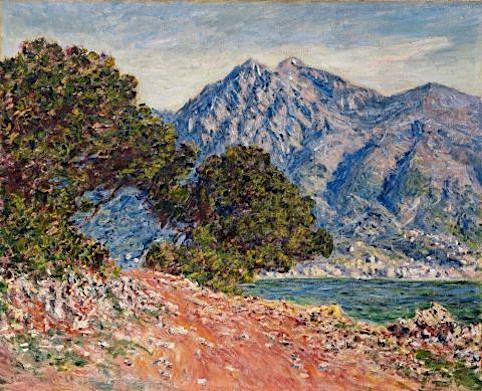CLAUDE MONET (1840-1926)
Le Mont Agel (1151 m)
France (Alpes Maritimes)
In Monte Carlo, Vu du Cap Martin
À propos de ce tableau
Claude Monet a peint le Mont Agel à de nombreuses reprises, mais les couleurs
et l'impression générale sont totalement différentes dans chaque
tableau. On peut comparer ses différentes toiles de ce mont. Celle-ci
est censée avoir été peinte au coucher du soleil. Monet, à l'instar des
peintres japonais, et notamment d'Hokusai qui a peint les 36 vues du
mont Fuji, a reproduit le même procédé artistique en peignant des séries
des mêmes montagnes, au même endroit, à différentes heures du jour ou à
différentes saisons. Au Cap Martin et au Mont Agel, Monet en a peint
une dizaine. Voir les autres versions ICI
La montagne
Le Mont Agel (1 151 m) est un
sommet des Alpes situé dans le sud de la France, dominant une partie de
la Côte d'Azur, Monaco, Beausoleil, Roquebrune-Cap-Martin… exactement
comme le montre le tableau de Monet ci-dessus !
Il occupe une
position stratégique historique depuis l'Antiquité et abrite encore
aujourd'hui des installations militaires de détection aérienne. Le mont
Agel est situé précisément sur la commune française de Peille (région
Provence-Alpes-Côte d'Azur). Il prend sa source dans les Préalpes
niçoises et constitue le point culminant du bassin versant monégasque.
Le point culminant de la principauté de Monaco, situé sur ses pentes,
est accessible par le chemin des Révoires. Sommet massif, le mont Agel
est visible de très loin : depuis certains quartiers de Nice, ainsi que
depuis une grande partie de la Côte d'Azur, entre Cannes, Antibes et la
Principauté de Monaco, et également depuis la Riviera italienne
jusqu'aux environs de Vintimille et de Bordighera. L'histoire du mont
Agel commence avec les tribus celto-ligures qui occupèrent le site et
dont certains membres furent impliqués dans l'arraisonnement et le
pillage des bateaux de cabotage. Elles sont soumises de 23 à 13 av.
J.-C. J.-C. par les Romains qui restaurent l'ancienne voie côtière
passant par les pentes du mont Agel pour relier Vintimille à la Gaule
narbonnaise et faisant partie de la Via Aurélia.
À partir de 1931, de nouveaux éléments de fortification furent construits dans le cadre de la ligne Maginot.
Le
mont Agel abrite aujourd'hui un important ouvrage d'artillerie équipé
de tourelles, reliées entre elles par des galeries profondément
enterrées. Lors des combats de juin 1940, ses tirs participèrent à la
défense de Menton et appuyèrent l'avant-poste de Pont-Saint-Louis et
l'ouvrage du Cap-Martin.
Jusqu'en 2012, la base aérienne 943 Capitaine Auber de l'Armée de l'air française y était implantée.
Aujourd'hui,
seuls subsistent les radars, qui poursuivent leur surveillance en mode
automatique, les informations étant transmises et exploitées par le
Centre de Détection et de Contrôle de la base aérienne 942 Lyon-Mont
Verdun.
Le mont Agel abrite également sur ses pentes le Monte-Carlo
Golf Club, un club très sélectif. Un peu à l'est du golf se trouve le
centre de transmission de Fontbonne. Jusqu'à son récent réaménagement,
on y trouvait diverses constructions protohistoriques.
À proximité du mont Agel et du golf se trouve également la résidence d'été des princes de Monaco (site de Rocagel).
Le peintre
Le
peintre Oscar-Claude Monet, plus connu sous le nom de Claude Monet, fut
l'un des fondateurs de la peinture impressionniste française et le
représentant le plus constant et le plus prolifique de la philosophie du
mouvement, qui consiste à exprimer ses perceptions face à la nature,
notamment dans la peinture de paysage en plein air. Le terme «
impressionnisme » dérive du titre de son tableau « Impression, soleil
levant », exposé en 1874 lors de la première des expositions
indépendantes organisées par Monet et ses associés comme alternative au
Salon de Paris.
L'ambition de Monet de documenter la campagne
française l'a conduit à adopter une méthode consistant à peindre la même
scène plusieurs fois afin de capturer le changement de lumière et le
passage des saisons, exactement comme l'artiste japonais Hokusai
(1760-1849) l'a fait avec ses 36 vues du mont Fuji. Monet a répété ce
type d'exercice de style avec sa série sur Les Petites Dalles et le mont
Kolsass.
Monet a été décrit comme « le moteur de l'impressionnisme
». La compréhension des effets de la lumière sur la couleur locale des
objets et des effets de la juxtaposition des couleurs était essentielle à
l'art des peintres impressionnistes. La longue carrière de Monet s'est
déroulée dans la poursuite de cet objectif.
En 1856, sa rencontre
fortuite avec Eugène Boudin, peintre de petites scènes de plage, lui a
ouvert les yeux sur la possibilité de peindre en plein air. Dès lors,
avec une courte interruption pour son service militaire, il s'est
consacré à la recherche de méthodes d'expression picturale nouvelles et
améliorées. À cette fin, jeune homme, il a visité le Salon de Paris,
s'est familiarisé avec les œuvres de peintres plus âgés et s'est lié
d'amitié avec d'autres jeunes artistes.[54] Les cinq années qu'il a
passées à Argenteuil, passant beaucoup de temps sur la Seine dans un
petit atelier flottant, ont été formatrices pour son étude des effets de
la lumière et réflexions. Il commença à penser en termes de couleurs et
de formes plutôt que de scènes et d'objets. Il utilisait des couleurs
vives en touches et en touches.
_______________________________________________
2025 - Gravir les montagnes en peinture
Un blog de Francis Rousseau


-%20falaises-pres-de-dieppe-%20-1896.jpg)














